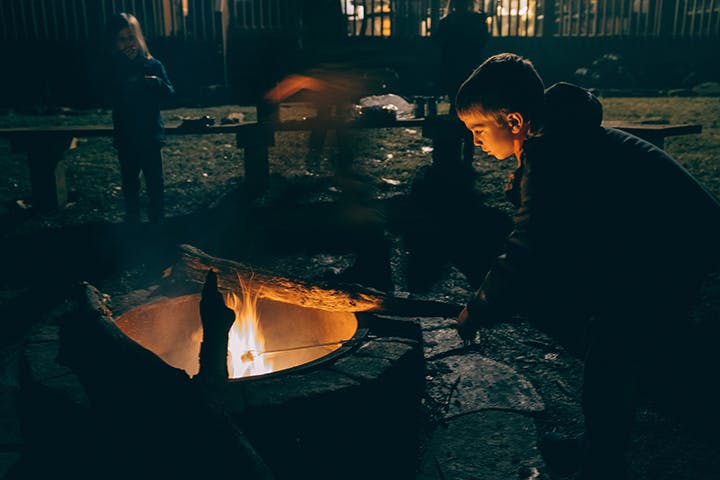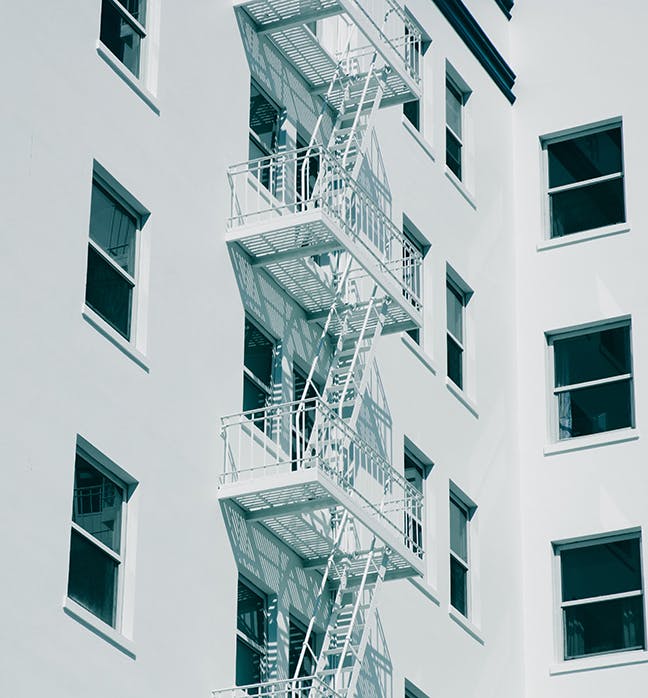
Every year, over 547,500 homes burn due to house fires or forest fires. Due to unmet fire regulations or poor fire planning, 6,500 people are killed, and 280,000 are injured in those house fires. Every home in the United States has a 50% chance of being involved in a house fire during the lifetime of the home.
That being said, house fires are serious. Families should prepare in advance in order to navigate a dangerous house fire situation. To help homeowners prepare for the worst, we’ve created a four-step safety plan that will protect your home and your family in the event of a house fire.

1. Teach All Family Members About Fire Safety
The first thing that you should do is teach every member of the family about fire safety. Whether you’re the only person in your household, or whether you have five kids, everyone should be aware of basic fire safety rules. This step will be the most extensive step because there is a lot to know about fire safety. To make the process easy, we’ve collected a list of the most important fire safety rules:
- Never leave the room while cooking. According to the National Fire Protection Association (NFPA), two out of five house fires are the result of a cooking accident. Appliances can become dangerous when they’re left on without supervision. Stovetop burners might catch fire on a nearby dish towel, or the oven might malfunction. Even the microwave can catch fire if left unattended. Home appliances need to be kept clean and functional to prevent them from causing a house fire. Most importantly, however, you need to make sure someone always has an eye on the kitchen.
- Teach children how to use the fire extinguisher. Fire extinguishers are typically filled with either dry chemicals or foam. Both types of fire extinguishers will smother a fire quickly and efficiently. They can stop fires from spreading, and they are an important tool to keep in the house. All family members should know how to use a fire extinguisher correctly.
- Don’t overload power outlets. Electrical fires are a fairly common culprit for house fires. Electrical outlets have a constant supply of power running through the outlet. If an outlet is overused or is supplying too many power strips with electricity, the electrical socket could spark. If the spark catches on a blanket, carpet, or window curtain, it can cause a fire that spreads quickly through the home. To prevent this from happening, teach your family members to keep a close eye on power strips by turning the strip off when they leave the room.
- Hide lighters and matches. When an individual uses a lighter or match without knowing how to use it, the incident could lead to a house fire or personal injury. Lighters and matches directly produce fire and, because of that, can easily lead to a house fire if a lighter or match is dropped on something flammable. Family members should be taught about how to safely handle matches and lighters, and they should not be left out in the open.
- Place electrical cords properly. As we mentioned, power cords can spark and start house fires if they are not used properly. Power cords should not be used on carpets or underneath carpets. You should not bend a power chord around a doorway or crush the power cord under a heavy object.
- Do not handle fire alone. Teach your family not to handle fire on their own. Whether they’re in the backyard, in their room, or in a forest of trees, no one should be alone with a fire. Campfires can spread quickly, or a child might accidentally start a fire in the corner of their room. Teach your children to use fire responsibly.
Knowing about fire safety is a vital lesson that all people should be taught. Take the time to go through fire safety rules to know what not to do around a fire.

2. Create a Fire Evacuation Plan
Based on the layout of your home, start creating different escape routes out of every room. Draw out a map and route two ways out of bedrooms and main living rooms. Then, draw two ways out of the house. With young children, show the map and explain why it is important to get out of the building quickly during a fire. After you’ve shown the map, hold a practice alarm drill, and walk through the escape plan from each room with each child. When the children can walk through the escape plan on their own, you’re ready to put the plan into action.
About twice a year, practice the escape plan with your family. Practice the escape plan randomly throughout the year to ensure that the plan doesn’t fade from your children’s minds. However, creating a practice escape plan needs to be done tactfully to make sure that you don’t scare any of your children. Explain to them that it’s unlikely that the house or building could catch on fire but that it’s always better to have a plan ready for action.
If you live in an apartment building, your escape route may look different. Since it’s possible that the stairs could be blocked by fire, you will need to practice ways of getting out of the top floor of the building. For apartments, there will be a fire escape located outside the window. The fire escape can be used as a ladder to exit the dangerous area. If you live in an apartment, it will be important to practice using the fire escape so that you will be able to safely descend during a fire. Exterior fire escapes are created for the sole purpose of leaving a dangerous situation and escaping the situation as safely as possible. In some cases, the fire escape will be located on the balcony of the apartment. In other apartment complexes, the fire escape will be more like a ladder out of the window. Because the fire escape can vary depending on the apartment, it’s important to practice using the fire escape beforehand.
If you live in a two-story house, it’s also possible that the interior stairs could become blocked during the fire. Because of the possibility, it’s important to install a fire escape outside of the window on the second floor or place a ladder on the second story for emergency escapes.
3. Teach Escape Techniques
When escaping a burning building, it’s important to know the right techniques in order to stay calm. Panicking in this situation can be dangerous since it can make a person irrational and breathe in more smoke. Practicing the right techniques for entering and exiting a fire zone is important because it can save the lives of everyone in the building.
It is not a viable plan to wait for the firefighters to come and retrieve you and your family from a burning building. Once the smoke detectors start going off in the building, leave the premises. If you are in your own home, attempt to put out the fire (if the fire is contained in a small location). However, if you are in your own home and you wake up to smoke, leave the area immediately.
When leaving a burning building, there are several things all people should know. First, before opening closed doors, press the back of your hand against the door handle. If the door handle is hot, do not open the door. Metal soaks in heat, meaning that it is a good indicator of how bad a fire has become outside of a contained area. If you open the door to a fire, you will let in more smoke and possibly spread the fire into the contained room.
If you find yourself trapped in a room with only a few doors and windows, look to the window. Push out any window air conditioners and try to escape through the window of the house. Hopefully, if you are prepared, there will be a metal fire escape (aka iron fire escape) close enough to the window that you can climb down. If there is no way to leave through the window, you may need to enter the hall. Because fires are unpredictable, it’s important to plan out the escape route and have emergency tools (like a fire extinguisher, ladder, or fire escape) close by.
Teach your children to crawl on the floor during a fire to avoid breathing in the smoke. Because smoke is lighter than air, the air closer to the ground will be cleaner and easier to breathe. This is important to teach your children because smoke can cause severe damage to your lungs over time and even suffocate you. When practicing how to escape a building during the fire, ensure that you also teach your children the importance of crawling and staying low to the floor.

- Fireproof Your Home Perhaps one of the most important things you can do is fireproof your home. Making your home “fireproof” will make it less likely that there will be a house fire. The very first thing you should do to make your home fireproof is place a ladder on the second floor of the house. We mentioned this earlier in the article but need to stress its importance. Fires are extremely unpredictable, which is part of the reason they are so dangerous. Often, rooms on the second story can only be accessed by one set of stairs, trapping the people upstairs if the fire is blocking the stairway. However, by putting a ladder upstairs, you provide the upstairs rooms with a way out of the house.
Another way to protect second-story rooms is by placing external fire escapes outside each window. You can buy a retractable fire escape that can be pulled back inside the window when it is not in use. This helps to ensure that all rooms have two ways to exit.
After you have installed either a ladder or fire escape on the second floor, install sprinklers that are activated by the smoke inside. Ceiling sprinklers are mandatory in commercial buildings but can be helpful in preventing fires from spreading in a residential home. When smoke reaches the sprinkler, an alarm will be set off, and the sprinklers will release a steady spray of water. The water will help to wet down any furniture and prevent the fire from spreading further. It also helps to put the fire out.

To make your home fireproof, you should also regularly clean your chimney and vents. Chimneys can hold soot and ash, building up debris for years. Sometimes, the debris can turn into creosote, an extremely flammable, oily buildup in chimney and stove vents. Cleaning out creosote will prevent accidental fires from starting.
The final thing that you should do is install a smart fire alarm. Smart fire alarms prevent thousands of fires every year because they are more efficient than a regular fire alarm. The difference between a smart fire alarm and a regular fire alarm is that the smart alarm has the ability to connect to your mobile device. Because it can connect to your phone, it can alert you of smoke while you’re away from the house. When a fire starts while no one is home, it’s often too late by the time a neighbor notices the smoke. By then, the flames are hot, and the damage will already be severe. With a smart alarm, you will know about the fire as soon as there is smoke. This means that you can send the fire department to your house before the fire is irreversible.
Preventing fires is about fire safety. Teach your family about how to prevent fires from happening near your home and instruct them about fire safety. Have a fire evacuation plan in place at all times and practice it throughout the year.
